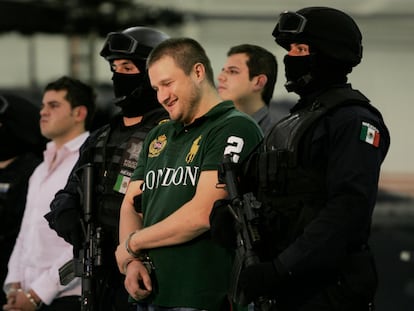The never-ending scourge of La Familia Michoacana
The cartel’s reign of terror in southern Mexico has gone unchecked for over 10 years
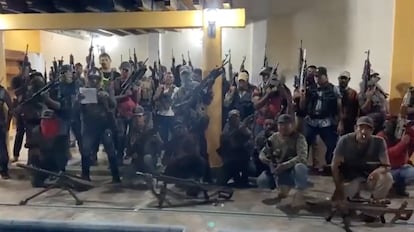
The image of the dead monkey in a bulletproof vest raced around the world. After all, it’s not something you see every day, not even in Mexico. The irony of the hitman monkey photo is that it overshadowed yet another bloody gun battle in the Tierra Caliente region of southern Mexico that killed 11 alleged members of the La Familia Michoacana cartel. People talked about the dead for a short while, with statistical detachment because such things are part of everyday life in Mexico these days.
Perhaps such commonplace violence is why the dead monkey photo distracted everyone from the grim ending to this shootout. It occurred on June 14 in Texcaltitlan, the gateway to the Tierra Caliente region that comprises some low-elevation areas of the states of Michoacán, Guerrero and Mexico. The public prosecutor for the state of Mexico said that local security forces were attacked by a group of cartel hitmen, and that some of the wounded attackers were captured, along with weapons, vehicles and other belongings. Later they named the criminal organization behind the attack: La Familia Michoacana, again.
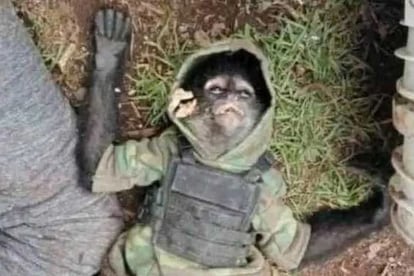
Long overshadowed by the rampant criminality of the media-savvy Jalisco New Generation Cartel (CJNG) and its allies, La Familia Michoacana has grabbed headlines recently with its increasingly aggressive assaults. Despite its name, the cartel operates mostly in the states of Mexico and Guerrero, where it has terrorized citizens for more than a decade. Now they seem to be expanding into new areas. In early December, La Familia Michoacana released a video in which a group of armed men aggressively announced their presence in Milpa Alta, a mostly rural borough on the southern fringe of Mexico City.
Mexican authorities have long monitored the group, which is led by two brothers – Jose Alfredo and Johnny Hurtado Olascoaga – who are on the government’s long list of wanted criminals, according to Mexican Army documents leaked by the Guacamaya hacktivist group a few months ago. The US government has also taken note. In November, the US Treasury Department sanctioned La Familia Michoacana and its leaders for drug smuggling. But La Familia is still here.
The Texcaltitlan shootout was the most recent in a series of ambushes and assaults in the state of Mexico by La Familia Michoacana, which has become one of the country’s longest-lived cartels, outlasting generational peers like Los Zetas. A few months ago, it ambushed and killed 13 police officers in Coatepec Harinas, a small town just a few hours to the southwest of Mexico City. Around the same time, it ambushed another group of police in Texcaltitlan, killing two and wounding six.
The capture of a La Familia leader in 2020 led the cartel to declare war on the region’s security forces, a conflict they brazenly announced in posters tacked up on the walls of towns and cities. For the next two years, their frequent attacks on police plagued the area. The shootout that killed the monkey seems to have marked the end of the clashes around Texcaltitlan, but the battlefront now has moved south to the state of Guerrero.
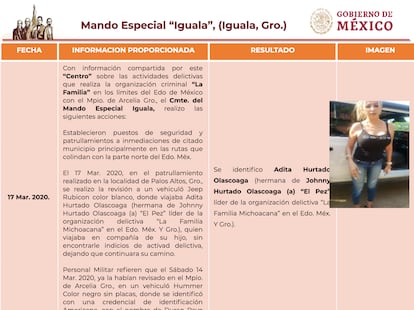
Criminal organizations like the CJNG and La Familia Michoacana have loosely defined territories, and alliances with groups that operate independently under their umbrella. While the CJNG acronym seems to be spray-painted everywhere, this often doesn’t imply a permanent presence in the area. Academics have described fast-food style franchising agreements between cartels and smaller groups who pay for the right to operate under the brand name.
Gangs use brand names to exploit fear factor
La Familia was born in the state of Michoacan around the turn of the century as a response to Los Zetas, which was beginning to expand from their home base in northeastern Mexico. Its leader, Nazario Moreno, put together an unusual organization with its own “bible” and code of ethics that purportedly existed for the good of the people. Maybe it once was, and maybe its original members really believed this, but over the years La Familia showed their true colors as yet another bunch of unscrupulous murderers and drug traffickers.
The arrests and deaths of Moreno and other leaders ultimately brought down La Familia Michoacana in its home state. The surviving members in Michoacan formed new groups with names like the Knights Templar, a spinoff that also espoused a quasi-religious and mystical creed. But in the states of Guerrero and Mexico, the brand name endured. While La Familia’s links to the original group in Michoacan may have withered and died, it has clearly established an almost impregnable fiefdom in large portions of Guerrero and the state of Mexico. Authorities have only managed to capture one of the cartel’s senior leaders over the years – Jose Maria Chavez Magaña (alias “El Pony”). Meanwhile, the Hurtado brothers continue to operate with impunity.
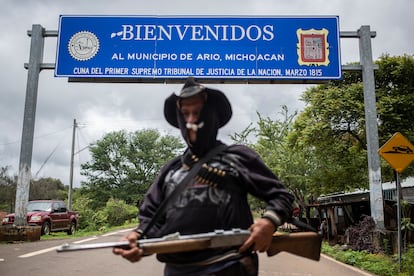
López Obrador administration targets La Familia
La Familia Michoacana has become a top concern for President Andrés Manuel López Obrador’s administration over the last two years. Following the latest bloodshed, federal officials raided properties allegedly linked to the group in late October. In early December, hitmen retaliated by murdering 20 people in San Miguel Totolapan (Guerrero), including the mayor and his father. A few weeks later, La Familia murdered seven people in nearby Coyuca.
During the raids, police were hoping to find clues that would lead them to the Hurtado brothers, who have been on the government’s wanted lists for more than 10 years. At least one of the houses searched in Guerrero may have belonged to Jose Alfredo Hurtado (alias “La Fresa”). The living room of the house was full of stuffed wild animals, including a lion. In other properties, officials found antelopes, a Bengal tiger, a lake with flamingos… but no sign of the Hurtado brothers.
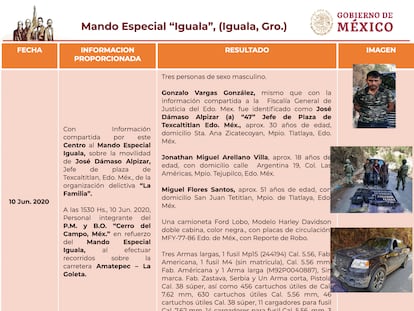
The trove of hacked Defense Ministry documents leaked by the Guacamaya group a few months ago reveals the Mexican government’s long-standing preoccupation with La Familia Michoacana. In November 2020, Mexican Army Intelligence (CERFI) officials presented an updated list of targets in the area. Its 13 priority targets included Johnny Hurtado (alias “El Pez”), and Juan Moreno Salgado (alias “Jabon”). Johnny Hurtado was believed to be based in Arcelia (Guerrero) near San Miguel Totolapan, and Juan Moreno Salgado was believed to be in Sultepec (Mexico), near Texcaltitlan. Moreno was alleged to have orchestrated the attacks against the prosecutor for the state of Mexico in 2020 and 2021.
Another leaked document describes the Mexican Army’s monitoring of La Familia meetings in 2020, and included photographs of La Familia members and reports of their movements. The document names the people responsible for various La Familia-controlled territories: Juan Moreno Salgado for Sultepec; Artemio Martínez Castrejón for Tenancingo; and Luis Gómez for the states of Mexico and Morelos.
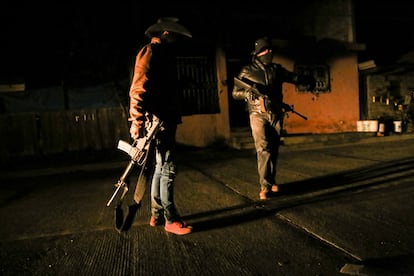
One leaked document reported that Johnny and José Alfredo Hurtado’s sister, Adita Hurtado Olascoaga, was temporarily detained in March 2020 at a police checkpoint. “She was traveling with her son,” states the document. “Since there was no evidence of criminal activity, she was allowed to continue on her way.” The same document also describes the circumstances leading to the arrest of one of Moreno’s lieutenants, Jose Damaso Alpizar, allegedly responsible for the Texcaltitlan territory. After CERFI provided the army’s Iguala Special Command with information on Alpizar’s movements, checkpoints were set up in Amatepec (Mexico), to the south of Sultepec and Texcaltitlan. On June 10, 2020, the army stopped a black Ford Lobo pickup truck carrying three men, one of whom was Alpizar. When they discovered three long guns, a pistol and ammunition in the truck, Alpizar was arrested.
After Alpizar’s arrest, La Familia Michoacana declared war in the state of Mexico. But no one seems to know what provoked the cartel’s most recent attacks against civilians and public officials in Guerrero.
Sign up for our weekly newsletter to get more English-language news coverage from EL PAÍS USA Edition
Tu suscripción se está usando en otro dispositivo
¿Quieres añadir otro usuario a tu suscripción?
Si continúas leyendo en este dispositivo, no se podrá leer en el otro.
FlechaTu suscripción se está usando en otro dispositivo y solo puedes acceder a EL PAÍS desde un dispositivo a la vez.
Si quieres compartir tu cuenta, cambia tu suscripción a la modalidad Premium, así podrás añadir otro usuario. Cada uno accederá con su propia cuenta de email, lo que os permitirá personalizar vuestra experiencia en EL PAÍS.
¿Tienes una suscripción de empresa? Accede aquí para contratar más cuentas.
En el caso de no saber quién está usando tu cuenta, te recomendamos cambiar tu contraseña aquí.
Si decides continuar compartiendo tu cuenta, este mensaje se mostrará en tu dispositivo y en el de la otra persona que está usando tu cuenta de forma indefinida, afectando a tu experiencia de lectura. Puedes consultar aquí los términos y condiciones de la suscripción digital.
More information
Archived In
Últimas noticias
Most viewed
- Sinaloa Cartel war is taking its toll on Los Chapitos
- Oona Chaplin: ‘I told James Cameron that I was living in a treehouse and starting a permaculture project with a friend’
- Reinhard Genzel, Nobel laureate in physics: ‘One-minute videos will never give you the truth’
- Why the price of coffee has skyrocketed: from Brazilian plantations to specialty coffee houses
- Silver prices are going crazy: This is what’s fueling the rally


